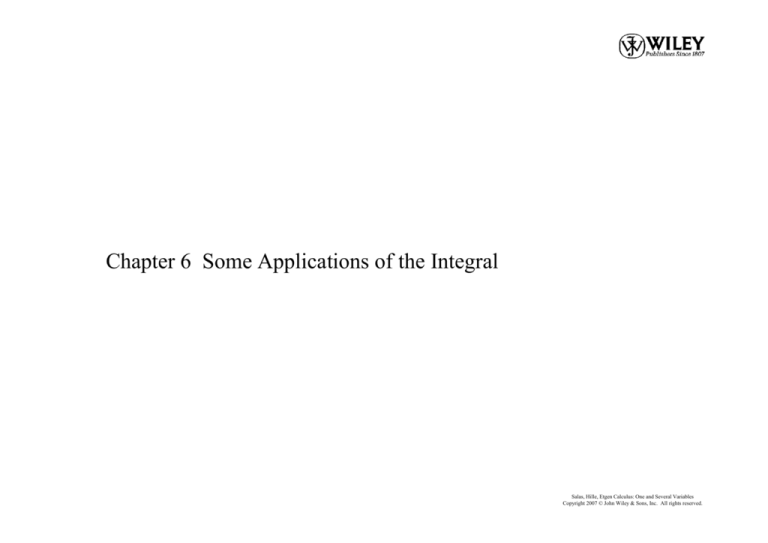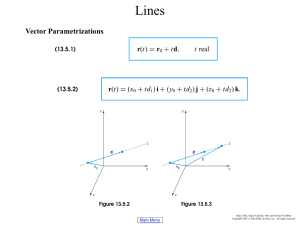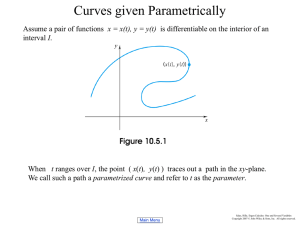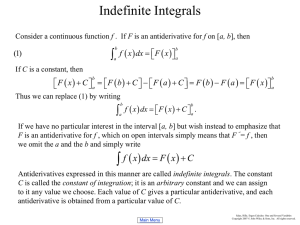
Chapter 6 Some Applications of the Integral
Main Menu
Salas, Hille, Etgen Calculus: One and Several Variables
Copyright 2007 © John Wiley & Sons, Inc. All rights reserved.
More on Area
Main Menu
Salas, Hille, Etgen Calculus: One and Several Variables
Copyright 2007 © John Wiley & Sons, Inc. All rights reserved.
More on Area
Integrating the vertical separation gives Riemann Sums of the form
Main Menu
Salas, Hille, Etgen Calculus: One and Several Variables
Copyright 2007 © John Wiley & Sons, Inc. All rights reserved.
More on Area
Example
Find the area A of the set shaded in Figure 6.1.4.
Solution
From x = −1 to x = 2 the vertical separation is the
difference 2x2 − (x4 − 2x2). Therefore
Main Menu
Salas, Hille, Etgen Calculus: One and Several Variables
Copyright 2007 © John Wiley & Sons, Inc. All rights reserved.
More on Area
Areas Obtained by Integration with Respect to y
In this case we are integrating with respect to y the horizontal separation F(y) − G( y)
from y = c to y = d.
Main Menu
Salas, Hille, Etgen Calculus: One and Several Variables
Copyright 2007 © John Wiley & Sons, Inc. All rights reserved.
More on Area
Example
Find the area of the region bounded on the left by the curve x = y2
and bounded on the right by the curve x = 3 − 2y2.
Solution
The region is sketched in Figure 6.1.6. The points of intersection
can be found by solving the two equations simultaneously:
x = y2
and
x = 3 − 2y2
together imply that
y = ±1.
The points of intersection are (1, 1) and (1,−1). The easiest way to
calculate the area is to set our representative rectangles
horizontally and integrate with respect to y. We then find the area
of the region by integrating the horizontal separation
(3 − 2y2) − y2 = 3 − 3y2
from y = −1 to y = 1:
A
1
1
3 3 y dy 3 y y
2
Main Menu
3 1
1 4
Salas, Hille, Etgen Calculus: One and Several Variables
Copyright 2007 © John Wiley & Sons, Inc. All rights reserved.
Volume by Parallel Cross Section; Disks and Washers
Figure 6.2.1 shows a plane region Ω and a solid formed by translating Ω
along a line perpendicular to the plane of Ω. Such a solid is called a right
cylinder with cross section Ω.
If Ω has area A and the solid has height h, then the volume of the solid is a
simple product:
V=A·h
Main Menu
(cross-sectional area · height)
Salas, Hille, Etgen Calculus: One and Several Variables
Copyright 2007 © John Wiley & Sons, Inc. All rights reserved.
Volume by Parallel Cross Section; Disks and Washers
If the cross-sectional area A(x) varies continuously with x, then we can find the
volume V of the solid by integrating A(x) from x = a to x = b:
Main Menu
Salas, Hille, Etgen Calculus: One and Several Variables
Copyright 2007 © John Wiley & Sons, Inc. All rights reserved.
Volume by Parallel Cross Section; Disks and Washers
Example
Find the volume of the pyramid of height h given that the base
of the pyramid is a square with sides of length r and the apex of
the pyramid lies directly above the center of the base.
Solution
Set the x-axis as in Figure 6.2.5. The cross section at
coordinate x is a square. Let s denote the length of the
side of that square. By similar triangles
1
s
2
hx
1
r
2
h
and therefore s
r
h x
h
The area A(x) of the square at coordinate x is
s2 = (r2 /h2)(h − x)2. Thus
Main Menu
Salas, Hille, Etgen Calculus: One and Several Variables
Copyright 2007 © John Wiley & Sons, Inc. All rights reserved.
Volume by Parallel Cross Section; Disks and Washers
Solids of Revolution: Disk Method
The volume of this solid is given by the formula
Main Menu
Salas, Hille, Etgen Calculus: One and Several Variables
Copyright 2007 © John Wiley & Sons, Inc. All rights reserved.
Volume by Parallel Cross Section; Disks and Washers
Example
We can generate a circular cone of base radius r and height h by revolving about the
x-axis the region below the graph of
f x
r
x,
h
0 xh
By (6.2.3),
2
r
r
volume of cone = 0 x dx 2
h
h
h
2
h
0
x 2 dx
r 2 x3
h
1 2
r h
h2 3 0 3
Main Menu
Salas, Hille, Etgen Calculus: One and Several Variables
Copyright 2007 © John Wiley & Sons, Inc. All rights reserved.
Volume by Parallel Cross Section; Disks and Washers
We can interchange the roles played by x and y. By revolving about the y-axis the
region of Figure 6.2.10, we obtain a solid of cross-sectional area A(y) = π[g(y)]2 and
volume
Main Menu
Salas, Hille, Etgen Calculus: One and Several Variables
Copyright 2007 © John Wiley & Sons, Inc. All rights reserved.
Volume by Parallel Cross Section; Disks and Washers
Example
Let Ω be the region bounded below by the curve y = x2/3 + 1, bounded to the left by the y-axis,
and bounded above by the line y = 5. Find the volume of the solid generated by revolving Ω
about the y-axis.
Solution We need to express the right boundary of Ω as a function of y:
y = x2/3 +1 gives x2/3 = y − 1 and thus x = (y − 1)3/2.
The volume of the solid obtained by revolving Ω about the y-axis is given by the integral
Main Menu
Salas, Hille, Etgen Calculus: One and Several Variables
Copyright 2007 © John Wiley & Sons, Inc. All rights reserved.
Volume by Parallel Cross Section; Disks and Washers
Solids of Revolution: Washer Method
The washer method is a slight generalization of the disk method. Suppose that f and g
are nonnegative continuous functions with g(x) ≤ f (x) for all x in [a, b]. If we revolve
the region Ω about the x-axis, we obtain a solid. The volume of this solid is given by
the formula
Main Menu
Salas, Hille, Etgen Calculus: One and Several Variables
Copyright 2007 © John Wiley & Sons, Inc. All rights reserved.
Volume by Parallel Cross Section; Disks and Washers
Example
Find the volume of the solid generated by revolving the region between
y = x2 and y = 2x
about the x-axis.
Solution
The curves intersect at the points (0, 0) and (2, 4).
For each x from 0 to 2, the x cross section is a washer of outer
radius 2x and inner radius x2. By (6.2.5),
Main Menu
Salas, Hille, Etgen Calculus: One and Several Variables
Copyright 2007 © John Wiley & Sons, Inc. All rights reserved.
Volume by Parallel Cross Section; Disks and Washers
As before, we can interchange the roles played by x and y.
Main Menu
Salas, Hille, Etgen Calculus: One and Several Variables
Copyright 2007 © John Wiley & Sons, Inc. All rights reserved.
Volume by Parallel Cross Section; Disks and Washers
Example
Find the volume of the solid generated by revolving the region between
y = x2 and y = 2x
about the y-axis.
Solution
The curves intersect at the points (0, 0) and (2, 4).
For each y from 0 to 4, the y cross section is a washer of outer radius y
and inner radius ½y. By (6.2.6),
Main Menu
Salas, Hille, Etgen Calculus: One and Several Variables
Copyright 2007 © John Wiley & Sons, Inc. All rights reserved.
Volume by the Shell Method
Now let [a, b] be an interval with a ≥ 0 and let f be a nonnegative function continuous
on [a, b]. If the region bounded by the graph of f and the x-axis is revolved about the
y-axis, then a solid is generated. The volume of this solid can be obtained from the
formula
Main Menu
Salas, Hille, Etgen Calculus: One and Several Variables
Copyright 2007 © John Wiley & Sons, Inc. All rights reserved.
Volume by the Shell Method
Example
Find the volume of the solid generated by revolving the region between
y = x2 and y = 2x
about the y-axis.
Solution
The curves intersect at the points (0, 0) and (2, 4).
For each x from 0 to 2 the line segment at a distance x
from the y-axis generates a cylindrical surface of radius x,
height (2x − x2), and lateral area 2πx(2x − x2). By (6.3.4),
Main Menu
Salas, Hille, Etgen Calculus: One and Several Variables
Copyright 2007 © John Wiley & Sons, Inc. All rights reserved.
Volume by the Shell Method
The volume generated by revolving Ω about the y-axis is given by the formula
Main Menu
Salas, Hille, Etgen Calculus: One and Several Variables
Copyright 2007 © John Wiley & Sons, Inc. All rights reserved.
Volume by the Shell Method
The volume generated by revolving Ω about the x-axis is given by the formula
Main Menu
Salas, Hille, Etgen Calculus: One and Several Variables
Copyright 2007 © John Wiley & Sons, Inc. All rights reserved.
Volume by the Shell Method
Example
Find the volume of the solid generated by revolving the region between
y = x2 and y = 2x
about the x-axis.
Solution
The curves intersect at the points (0, 0) and (2, 4).
We begin by expressing the bounding curves as functions of y.
We write x = y for the right boundary and x = ½y for the left
boundary. For each y from 0 to 4 the line segment at a distance y
from the x-axis generates a cylindrical surface of radius y, height
( y − ½y), and lateral area 2πy( y − ½y).
By (6.3.5),
Main Menu
Salas, Hille, Etgen Calculus: One and Several Variables
Copyright 2007 © John Wiley & Sons, Inc. All rights reserved.
Arc Length
Figure 10.7.1 represents a curve C parametrized by a pair of functions
x = x(t),
y = y(t)
t [a, b].
We will assume that the functions are continuously differentiable on [a, b] (have
first derivatives which are continuous on [a, b]). We want to determine the
length of C.
Main Menu
Salas, Hille, Etgen Calculus: One and Several Variables
Copyright 2007 © John Wiley & Sons, Inc. All rights reserved.
Arc Length
The length of the path C traced out by a pair of continuously differentiable
functions
x = x(t),
y = y(t)
t [a, b]
is given by the formula
Main Menu
Salas, Hille, Etgen Calculus: One and Several Variables
Copyright 2007 © John Wiley & Sons, Inc. All rights reserved.
Arc Length
Suppose now that C is the graph of a continuously differentiable function
y = f (x), x [a, b].
We can parametrize C by setting
x(t) = t,
y(t) = f (t)
t [a, b].
Since
x´(t) = 1
and
y´(t) = f´(t),
(10.7.1) gives
L C
b
a
1 f t dt
2
Replacing t by x, we can write:
Main Menu
Salas, Hille, Etgen Calculus: One and Several Variables
Copyright 2007 © John Wiley & Sons, Inc. All rights reserved.






